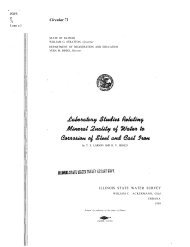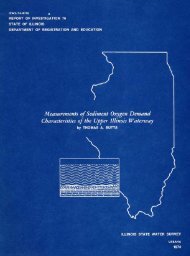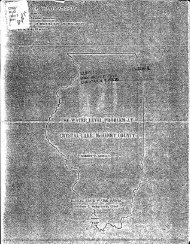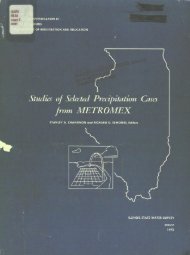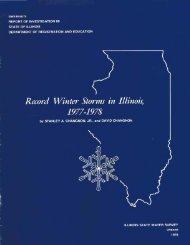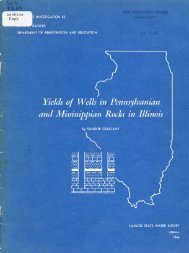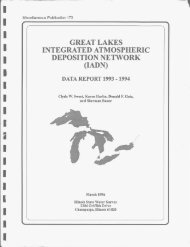<strong>for</strong> determining values of the parameters T <strong>and</strong> P´ understeady-state leaky artesian conditions. A steady-state leakyartesian type curve is prepared by plotting values ofK o (r/B) against values of r/B on logarithmic paper asshown in plate 2. Values of K o (r/B) in terms of the practicalrange of r/B are given in appendix B. <strong>Aquifer</strong>-testdata collected under steady-state conditions are plotted onlogarithmic paper of the same scale as the type curve withr as the abscissa <strong>and</strong> s as the ordinate to describe a distancedrawdownfield data curve. A match of the two curves isobtained by superposing the distance-drawdown field datacurve over the steady-state leaky artesian type curve, keepingthe axes of the two graphs parallel. In the matchedposition a point at the intersection of the major axes of thesteady-state leaky artesian type curve is selected <strong>and</strong> markedon the distance-drawdown field data curve. Match-pointcoordinates K o (r/B), r/B, s, <strong>and</strong> r are substituted intoequations 12 <strong>and</strong> 13 to determine T <strong>and</strong> P´. The coefficientof storage cannot be computed by use of the steady-stateleaky artesian type curve because, under such conditions offlow, the entire yield of the well is derived from leakagesources only.Nonleaky Artesian FormulaIf leakage through the confining bed into the aquifer isnot measurable or the confining bed is missing, equation 9becomess = (114.6Q/T) W (u) (14)where:<strong>and</strong>u =s=Q =T =r =2693r²S/Ttdrawdown in observation well, in ftdischarge, in gpmcoefficient of transmissibility, in gpd/ftdistance from observation well to pumpedwell, in ft(15)S = coefficient of storage, fractiont = time after pumping started, in minEquation 14 is the nonequilibrium <strong>for</strong>mula introducedby Theis (1935) <strong>and</strong> will be referred to hereafter as thenonleaky artesian <strong>for</strong>mula. W(u) is the “well function <strong>for</strong>nonleaky artesian aquifers” (see Wenzel, 1942).If leakage is not measurable during the aquifer test orthe confining bed is missing, the time-drawdown field datacurve will be analogous to the nonleaky artesian type curvewhich is shown in plate 1 as the outside curve of the familyof leaky artesian type curves. The time-drawdown field datacurve <strong>and</strong> the nonleaky artesian type curve are matched6<strong>and</strong> match point coordinates W(u), l/u, s, <strong>and</strong> t are substitutedinto equations 14 <strong>and</strong> 15 to determine T <strong>and</strong> S.The coefficients of transmissibility <strong>and</strong> storage can alsobe computed with distance-drawdown data under nonleakyartesian conditions. Values of W(u), given by Wenzel(1942) <strong>and</strong> presented in tabular <strong>for</strong>m in appendix C,were plotted against values of u on logarithmic paper toobtain the nonleaky artesian type curve in plate 3. Valuesof s measured at the same time in several wells at variousdistances from the pumped well are plotted against thesquares of the respective distances on logarithmic paper ofthe same scale as the type curve to obtain a distance-drawdownfield data curve. The distance-drawdown field datacurve is superposed on the nonleaky artesian type curvekeeping the axes of the two graphs parallel. In the matchedposition a point at the intersection of the major axes of thenonleaky artesian type curve is selected <strong>and</strong> marked on thedistance-drawdown field data curve. Match-point coordinatesW(u), u, s, <strong>and</strong> r ² are substituted into equations 14<strong>and</strong> 15 to determine T <strong>and</strong> S.Water-Table ConditionsThe methods described in preceding paragraphs pertainto leaky artesian <strong>and</strong> nonleaky artesian conditions. Thenonleaky artesian <strong>for</strong>mula can be applied to the results ofaquifer tests made with wells in water-table aquifers undercertain limiting conditions. The nonleaky artesian <strong>for</strong>mulawas developed in part on the basis of the following assumptions:that the coefficient of storage is constant <strong>and</strong> thatwater is released from storage instantaneously with a declinein head. Under water-table conditions, water is derivedlargely from storage by the gravity drainage of theinterstices in the portion of the aquifer unwatered by thepumping. The gravity drainage of water through stratifiedsediments is not immediate <strong>and</strong> the nonsteady flow of watertowards a well in an unconfined aquifer is characterized byslow drainage of interstices. Thus, the coefficient of storagevaries <strong>and</strong> increases at a diminishing rate with the time ofpumping. The important effects of gravity drainage are notconsidered in the nonleaky artesian <strong>for</strong>mula <strong>and</strong> that<strong>for</strong>mula does not describe completely the drawdown inwells especially during short periods of pumping. With longperiods of pumping the effects of gravity drainage becomesmall <strong>and</strong> time-drawdown <strong>and</strong> distance-drawdown curvescon<strong>for</strong>m closely to the nonleaky artesian type curve.According to Boulton (1954a) whether or not the nonleakyartesian <strong>for</strong>mula gives a good approximation of thedrawdown in a well under water-table conditions dependson the distance of the observation well from the pumpedwell r, the hydraulic properties of the aquifer, the saturatedthickness of the aquifer m, <strong>and</strong> a dimensionless “time factor.”He further implies that the nonleaky artesian <strong>for</strong>muladescribes the drawdown in wells with sufficient accuracy <strong>for</strong>practical purposes when the time factor is greater than 5<strong>and</strong> r is between about 0.2 m <strong>and</strong> 6 m. By substituting anumerical value equal to 5 <strong>for</strong> Boulton’s time factor, thefollowing equation can be derived:t wt = 37.4S y m/P (16)where:t wt = approximate time after pumping starts when the
S y =P =m =application of the nonleaky artesian <strong>for</strong>mula tothe results of aquifer tests under water-table conditionsis justified, in daysspecific yield, fractioncoefficient of permeability, in gpd/sq ftsaturated thickness of aquifer, in ftThe above equation is not valid when r is less than about0.2 m or greater than about 6 m. For observation wells atgreat distances from the pumped well, t wt must be somethinggreater than that given by equation 16 be<strong>for</strong>e thenonleaky artesian <strong>for</strong>mula can be applied to aquifer-testdata. It is evident that t wt is small if an aquifer is thin <strong>and</strong>very permeable. For example, t wt is about 1 hour if anobservation well is close to a pumped well <strong>and</strong> penetratesan aquifer 30 feet thick with a coefficient of permeability of5000 gpd/sq ft. In contrast, substituting the data <strong>for</strong> athick aquifer of low permeability (m = 200 feet <strong>and</strong> P =1000 gpd/sq ft) in equation 16 results in a t wt of about 1.5days.Gravity drainage of interstices decreases the saturatedthickness <strong>and</strong> there<strong>for</strong>e the coefficient of transmissibility ofthe aquifer. Under water-table conditions, observed valuesof drawdown must be compensated <strong>for</strong> the decrease insaturated thickness be<strong>for</strong>e the data can be used to determinethe hydraulic properties of the aquifer. The following equationderived by Jacob (1944) is used to adjust drawdowndata <strong>for</strong> decrease in the coefficient of transmissibility:s' = s — (s² /2 m) (17)where:s´ = drawdown that would occur in an equivalentnonleaky artesian aquifer, in fts = observed drawdown under water-table conditions,in ftm = initial saturated thickness of aquifer, in ftUnder water-table conditions values of drawdown adjusted<strong>for</strong> decreases in saturated thickness are plottedagainst the logarithms of values of t to describe a timedrawdownfield data curve. The time-drawdown field datacurve is superposed on the nonleaky artesian type curve,keeping the axes of the two curves parallel. The time-drawdownfield data curve is matched to the nonleaky artesiantype curve. Emphasis is placed on late time-drawdown data(usually after several minutes or hours of pumping) becauseearly time-drawdown data are affected by gravity drainage.Match-point coordinates W(u) , l/u, s, <strong>and</strong> t are substitutedinto equations 14 <strong>and</strong> 15 to determine T <strong>and</strong> S. After tentativevalues of T <strong>and</strong> S have been calculated, t wt is computedfrom equation 16. The time t wt is compared with theearly portion of data ignored in matching curves. If thetype curve is matched to drawdown data <strong>for</strong> values of timeequal to <strong>and</strong> greater than t wt then the solution is judged tobe valid. If the type curve is matched to drawdown data<strong>for</strong> values of time earlier than t wt then the solution is notcorrect <strong>and</strong> the time-drawdown field data curve is re-matched to the nonleaky artesian type curve <strong>and</strong> the proceduresmentioned earlier are repeated until a valid solutionis obtained.Gravity drainage is far from complete during the averageperiod (8 to 24 hours) of aquifer tests; there<strong>for</strong>e, the coefficientof storage computed with data collected underwater-table conditions will generally be less than the specificyield of the aquifer <strong>and</strong> it cannot be used to predict longtermeffects of pumping. It should be recognized that thecoefficient of storage computed from test results applieslargely to the part of the aquifer unwatered by pumping<strong>and</strong> it may not be representative of the aquifer at lowerdepths.Partial PenetrationProduction <strong>and</strong> observation wells often do not completelypenetrate aquifers. The partial penetration of a pumpingwell influences the distribution of head in its vicinity, affectingthe drawdowns in nearby observation wells. The approximatedistance r pp from the pumped well beyond whichthe effects of partial penetration are negligible is given bythe following equation (see Butler, 1957):(18)where:m = saturated thickness of aquifer, in ftP h = horizontal permeability of aquifer, in gpd/sq ftP v = vertical permeability of aquifer, in gpd/sq ftAccording to Hantush (1961), the effects of partial penetrationclosely resemble the effects of leakage through aconfining bed, the effects of a recharge boundary, the effectsof a sloping water-table aquifer, <strong>and</strong> the effects of anaquifer of nonuni<strong>for</strong>m thickness. He outlines methods <strong>for</strong>analysis of time-drawdown data affected by partial penetrationunder nonsteady state, nonleaky artesian conditions.In many cases distance-drawdown data can be adjusted<strong>for</strong> partial penetration according to methods described byButler (1957). If the pumped well only partially penetratesan aquifer, the cone of depression is distorted <strong>and</strong>observed drawdowns in observation wells differ from theoreticaldrawdowns <strong>for</strong> a fully penetrating well accordingto the vertical position of the observation well. If thepumped <strong>and</strong> observation wells are both open in either thetop or the bottom portion of the aquifer, the observeddrawdown in the observation well is greater than <strong>for</strong> fullypenetrating conditions. If the pumped well is open to thetop of the aquifer <strong>and</strong> the observation well is open to thebottom of the aquifer, or vice versa, the observed drawdownin the observation well is smaller than <strong>for</strong> fully penetratingconditions.In the case where both the pumped <strong>and</strong> observation wellsare open in the same zone of the aquifer, the followingequation (see Butler, 1957) can be used to adjust observeddrawdowns in observation wells <strong>for</strong> the effects of partialpenetration:s = C po s pp(19)7
- Page 1: BULLETIN 49STATE OF ILLINOISDEPARTM
- Page 4 and 5: PAGEModel aquifer and mathematical
- Page 6: ivFIGURE65 Model aquifers and mathe
- Page 9 and 10: Part 1. Analysis of Geohydrologic P
- Page 11: aquifers” (Hantush, 1956) and is
- Page 15 and 16: yond ln u becomes insignificant. Wh
- Page 18 and 19: point D(u) q , l/u², s, and t are
- Page 20 and 21: it is required to estimate the rang
- Page 22 and 23: emain as it was because it would ca
- Page 25 and 26: The computed value of T and other k
- Page 27 and 28: part of 90°.” Under the foregoin
- Page 29 and 30: however, ground-water runoff under
- Page 31 and 32: the hydraulic properties of the aqu
- Page 33 and 34: Well LossThe components of drawdown
- Page 35 and 36: a screen and an optimum screen entr
- Page 37 and 38: Part 3. Illustrative Examples of An
- Page 39 and 40: properties of the aquifer and confi
- Page 41 and 42: downs in the observation wells were
- Page 43 and 44: Figure 33.Thickness of dolomite of
- Page 45 and 46: constructed with figure 34 by the p
- Page 47 and 48: increases in the yields of newly co
- Page 49 and 50: Effects of Acid TreatmentAcid treat
- Page 51 and 52: Coefficient of TransmissibilityThe
- Page 53 and 54: Formation, probably the least perme
- Page 55 and 56: of water levels after 53 hours of p
- Page 57 and 58: 45 and 46 were used to determine th
- Page 59 and 60: cross sections A—A' and B—B' is
- Page 61 and 62: water storage during 1951, 1952, an
- Page 63 and 64:
and the coefficient of transmissibi
- Page 65 and 66:
200,000 gpd (Walker and Walton, 196
- Page 67 and 68:
and the source of recharge is preci
- Page 69 and 70:
gpd/ft and 410 gpd/sq ft, respectiv
- Page 71 and 72:
The test was started at 11:20 a.m.
- Page 73 and 74:
projects from the caisson at a dept
- Page 75 and 76:
ConclusionsIt is often possible to
- Page 77 and 78:
Hantush, M. S. 1957b. Preliminary q
- Page 79 and 80:
APPENDIX AVALUES OF W (u, r/B)r / B
- Page 81 and 82:
APPENDIX A (CONTINUED)VALUES OF W(u
- Page 83 and 84:
NAPPENDIX B (CONTINUED)VALUES OF Ko
- Page 85 and 86:
λr w/BAPPENDIX DVALUES OF G(λ, r
- Page 87:
APPENDIX FSelected Conversion Facto




